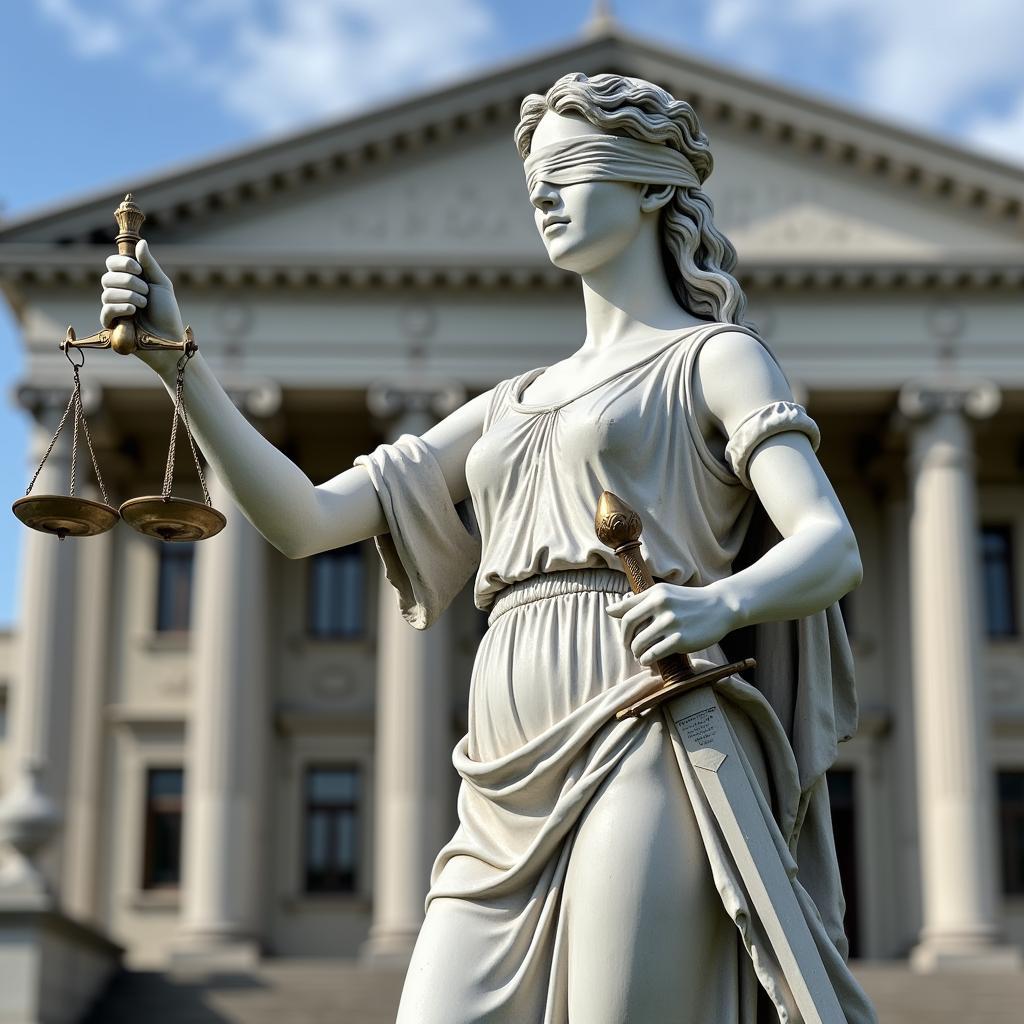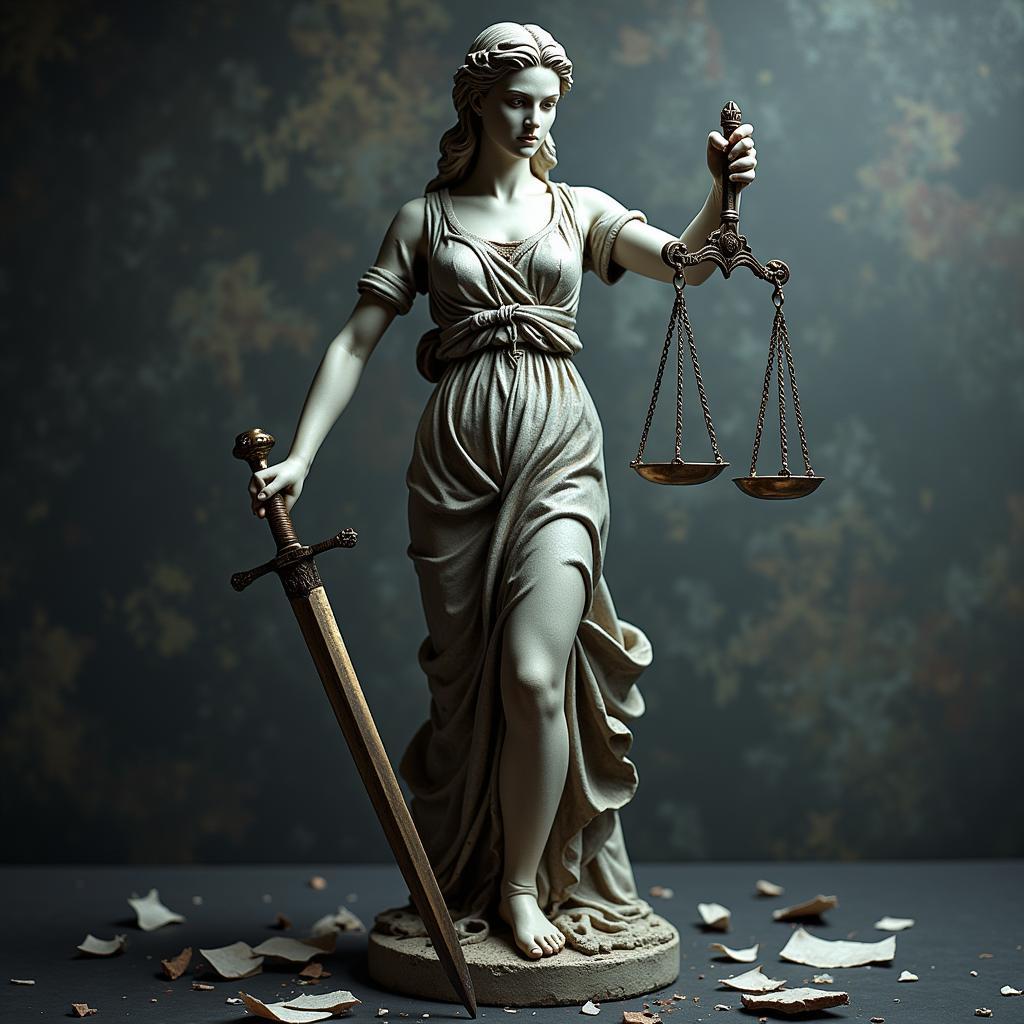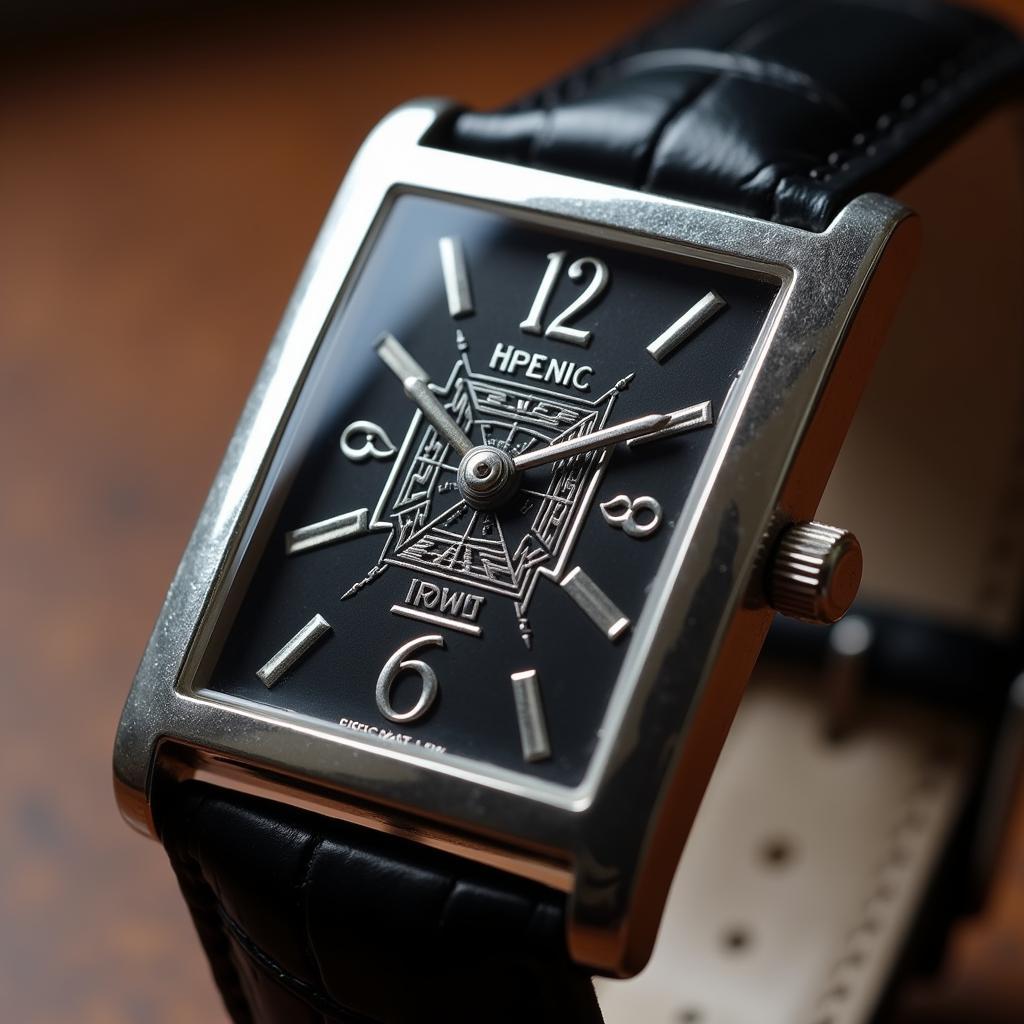Exploring the Depths of Blind Justice Art
Blind Justice Art, a powerful visual representation of impartiality and fairness within the legal system, has captivated artists and viewers for centuries. From classical sculptures to modern digital art, the image of Lady Justice, often blindfolded and holding scales and a sword, continues to resonate with profound meaning. But what lies beneath the surface of these symbolic depictions? Let’s delve into the fascinating world of Blind Justice art and explore its intricate layers of meaning, historical context, and contemporary interpretations. Check out these impressive scales of justice wall art.
The Symbolism of Blind Justice: More Than Meets the Eye
The iconic imagery associated with Blind Justice is rich with symbolism. The blindfold represents objectivity, ensuring that justice is served without bias or prejudice. The scales symbolize balance and fairness, weighing the evidence to determine a just outcome. The sword represents the enforcement of the law, signifying the power and authority of the legal system. However, these symbols aren’t static; their interpretation has evolved throughout history, reflecting changing societal values and legal principles.
What does it truly mean for justice to be “blind”? Does it imply an absolute absence of bias, or is it a more nuanced concept? The very notion of “blindness” can be interpreted in various ways, leading to ongoing discussions about the complexities of achieving true impartiality in the legal system.
 Classical Representation of Blind Justice Statue
Classical Representation of Blind Justice Statue
The Historical Evolution of Blind Justice Art
From ancient Greece to the modern era, the image of Blind Justice has undergone significant transformations. While the core symbols have remained relatively consistent, their artistic representation and cultural significance have evolved. In ancient depictions, Justice was often portrayed with open eyes, suggesting that true justice required clear sight and understanding. The blindfold appeared later, symbolizing the ideal of impartiality in legal proceedings.
The artistic styles used to depict Blind Justice also reflect the prevailing artistic movements of each era. From classical sculptures to Renaissance paintings and contemporary digital art, each artistic medium offers a unique perspective on the concept of justice. Exploring this historical evolution reveals not only the changing aesthetics of Blind Justice art but also the shifting cultural perceptions of law and fairness.
Blind Justice in Contemporary Art: Challenging the Narrative
Modern artists continue to engage with the theme of Blind Justice, often challenging traditional interpretations and exploring new perspectives. Some artists subvert the classic imagery to critique systemic biases and injustices within the legal system. Others utilize new technologies and artistic mediums to create thought-provoking pieces that spark dialogue about the future of justice.
 Modern Digital Interpretation of Blind Justice
Modern Digital Interpretation of Blind Justice
Protect me from what I want art can also be interpreted through the lens of justice, questioning our desires and their potential consequences within a societal framework.
What role does art play in shaping our understanding of justice? Can art be a catalyst for social change and legal reform? Contemporary artists are pushing the boundaries of traditional representation, prompting critical reflection on the complexities of justice in the 21st century.
Interpreting Blind Justice: A Multifaceted Perspective
The interpretation of Blind Justice art isn’t confined to legal scholars and art historians. It resonates with individuals on a personal level, prompting introspection about fairness, equality, and the pursuit of justice in everyday life. Whether viewing a classical sculpture or a modern digital artwork, we are invited to engage with the symbolic language of Blind Justice and contemplate its relevance in our own experiences.
Dr. Amelia Hernandez, a renowned art historian, states, “Blind Justice art is not merely a static representation of legal principles. It is a dynamic conversation about the ongoing struggle for fairness and equality within society.”
The Future of Blind Justice Art: A Digital Renaissance?
With the rise of digital art and new technologies, the future of Blind Justice art is ripe with possibilities. Virtual reality, augmented reality, and artificial intelligence offer exciting new avenues for artistic expression and engagement. Imagine stepping into a virtual courtroom where you can interact with a three-dimensional representation of Lady Justice or exploring an interactive artwork that allows you to manipulate the scales and contemplate the consequences of different legal decisions.
Professor David Miller, a legal scholar and technology expert, believes that “digital art has the potential to revolutionize our understanding of Blind Justice by creating immersive and interactive experiences that engage audiences in new and meaningful ways.”
Conclusion
Blind Justice art serves as a powerful reminder of the ongoing pursuit of fairness and impartiality within the legal system. From its ancient roots to its contemporary interpretations, the imagery of Blind Justice continues to inspire reflection and dialogue about the complexities of justice in our world. By exploring the historical evolution, symbolic meanings, and artistic representations of Blind Justice, we gain a deeper understanding of the challenges and triumphs in the ongoing quest for a more just and equitable society. Remember to explore the intriguing protect me from what i want art.
FAQ
- What does the blindfold on Lady Justice represent? (Objectivity and impartiality)
- What do the scales held by Lady Justice symbolize? (Balance and fairness)
- How has the depiction of Blind Justice changed throughout history? (From open eyes to blindfolded, reflecting evolving views on justice.)
- How do contemporary artists interpret Blind Justice? (Often challenging traditional narratives and exploring new perspectives on systemic issues.)
- What is the significance of Blind Justice art in the digital age? (New technologies offer exciting opportunities for interactive and immersive experiences.)
- What is the meaning of “scales of justice wall art”? (Artwork depicting the scales of justice, symbolizing balance and fairness, suitable for wall display.)
- Where can I find more information on Blind Justice in art and history? (Museums, art history books, online resources dedicated to art and legal history).
Common Scenarios and Questions
- Scenario: A student is researching the historical evolution of Blind Justice for an art history project. Question: Where can I find reliable sources on the different artistic representations of Blind Justice throughout history?
- Scenario: An artist is seeking inspiration for a new piece on the theme of justice. Question: What are some innovative ways to interpret the imagery of Blind Justice in contemporary art?
- Scenario: A lawyer is decorating their office and wants to incorporate artwork that reflects the principles of justice. Question: Where can I purchase high-quality Blind Justice art prints or sculptures?
Further Exploration
You might also be interested in exploring other articles on our website related to legal symbolism, art history, and the intersection of art and social justice.
For any assistance, please contact us at Phone Number: 02462573573, Email: danteum@gmail.com Or visit our address: Savico Megamall, 7-9 Đ. Nguyễn Văn Linh, Gia Thụy, Long Biên, Hà Nội 10000, Việt Nam. We have a 24/7 customer support team.


